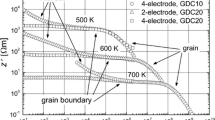Abstract
The non-isothermal sintering process of cerium dioxide containing gadolinium sesquioxide powders within a wide range of specific surface area was investigated by dilatometry. Linear shrinkage data of powder compacts were recorded under several constant rates of heating. Dilatometry data were analyzed by two methodologies enabling to preview the relative density for any temperature/time profile, and determination of the apparent activation energy for sintering. Correlation of dilatometry results with microstructure evolution was also carried out. Remarkable differences in sintering powders with different specific surface areas were found. The apparent activation energy for sintering increases with decreasing specific surface area and, in most cases, it does not change significantly in the approximately 70–85% range of relative density.









Similar content being viewed by others
References
Yahiro H, Eguchi Y, Eguchi K, Arai H. Oxygen-ion conductivity of the ceria-samarium oxide system with fluorite structure. J Appl Electrochem. 1988;18:527–31.
Yahiro H, Eguchi K, Arai H. Electrical properties and reducibilities of ceria-rare earth oxide systems and their application to solid oxide fuel cell. Solid State Ion. 1989;36:71–5.
Steele BCH, Heinzel A. Materials for fuel-cell technologies. Nature. 2001;414:345–52.
Inaba H, Nakajima T, Tagawa H. Sintering behaviors of ceria and gadolinia-doped ceria. Solid State Ion. 1998;106:263–8.
Jurado JR. Present several items on ceria-based ceramic electrolytes: synthesis, additive effects, reactivity and electrochemical behavior. J Mater Sci. 2001;36:1133–9.
He Z, Yuan H, Glasscock JA, Chatzichristodoulou C, Phair JW, Kaiser A, Ramousse S. Densification and grain growth during early-stage sintering of Ce0.9Gd0.1O1.95-δ in a reducing atmosphere. Acta Mater. 2010;58:3860–6.
Batista RM, Ferreira AMDC, Muccillo ENS. Sintering and electrical conductivity of gadolinia-doped ceria. Ionics. 2016;22:1159–66.
Batista RM, Muccillo ENS. Dilatometry analysis of the sintering process of nanostructured gadolinia-doped ceria. J Therm Anal Calorim. 2016;126:1007–13.
Malghe YS, Dharwadkar SR, Krishnan K, Mudher KDS. Dilatometry and high temperature X-ray diffractometry study of LaCrO3 prepared using microwave heating. J Therm Anal Calorim. 2009;95:49–52.
Durrani SK, Naz S, Nadeem M, Khan AA. Thermal, structural and impedance analysis of nanocrystalline magnesium chromite spinel synthesized via hydrothermal process. J Therm Anal Calorim. 2014;116:309–20.
Surzhikov AP, Ghyngazov SA, Frangulyan TS, Vasil’ev IP, Chernyavskii AV. Investigation of sintering behaviour of ZrO2 (Y) ceramic green body by means of non-isothermal dilatometry and thermokinetic analysis. J Therm Anal Calorim. 2017;128:787–94.
Erceg M, Krešić I, Jakić M, Andričić B. Kinetic analysis of poly(ethylene oxide)/lithium montmorillonite nanocomposites. J Therm Anal Calorim. 2017;127:789–97.
Hansen J, Rusin RP, Teng M, Johnson DL. Combined-stage sintering model. J Am Ceram Soc. 1992;75:1129–35.
Su H, Johnson DL. Master sintering curve: a practical approach to sintering. J Am Ceram Soc. 1996;79:3211–7.
Batista RM, Naranjo JFR, Muccillo ENS. A versatile software for construction of the máster sintering curve. Mater Sci Forum. 2018;912:240–4.
Wang J, Raj R. Estimate of activation energies for boundary diffusion from rate-controlled sintering of pure alumina, and alumina doped with zirconia or titania. J Am Ceram Soc. 1990;73:1172–5.
Larson AC, Deele RB von. General structure analysis system (GSAS), Los Alamos National Laboratory Report LAUR 86-748, 1994.
Kudo T, Obayashi H. Oxygen ion conduction of the fluorite-type Ce1−xLnxO2−x/2 (Ln = Lanthanoid element). J Electrochem Soc. 1975;122:142–7.
Kharton VV, Figueiredo FM, Navarro L, Naumovich EN, Kovalevsky AV, Yaremchenko AA, Viskup AP, Carneiro A, Marques FMB, Frade JR. Ceria-based materials for solid oxide fuel cells. J Mater Sci. 2001;36:1105–17.
Ewsuk KG, Ellerby DT, DiAntonio CB. Analysis of nanocrystalline and microcrystalline ZnO sintering using master sintering curves. J Am Ceram Soc. 2006;89:2003–9.
Young WS, Cutler IB. Initial sintering with constant rates of heating. J Am Ceram Soc. 1970;53:659–63.
Aminzare M, Mazaheri M, Golestani-fard F, Rezaie HR, Ajeian R. Sintering behavior of nano alumina powder shaped by pressure filtration. Ceram Int. 2011;37:9–14.
Rajeswari K, Padhi S, Reddy ARS, Johnson R, Das D. Studies on sintering kinetics and correlation with the sinterability of 8Y zirconia ceramics based on the dilatometric shrinkage. Ceram Int. 2013;39:4985–90.
Rahaman MN. Sintering of ceramics. Boca Raton: CRC Press; 2008.
Acknowledgements
The authors acknowledge FAPESP (2013/07296-2), CNPq (Proc. no. 304073/2014-8) and CNEN for financial supports, and the Laboratory of Electron Microscopy at IPEN for TEM observation. One of the authors (R.M.B.) acknowledges Capes for the scholarship.
Author information
Authors and Affiliations
Corresponding author
Rights and permissions
About this article
Cite this article
Batista, R.M., Muccillo, E.N.S. Analysis of the sintering process in gadolinia-doped ceria by thermodilatometry and correlation with microstructure evolution. J Therm Anal Calorim 132, 851–857 (2018). https://doi.org/10.1007/s10973-018-6969-5
Received:
Accepted:
Published:
Issue Date:
DOI: https://doi.org/10.1007/s10973-018-6969-5




